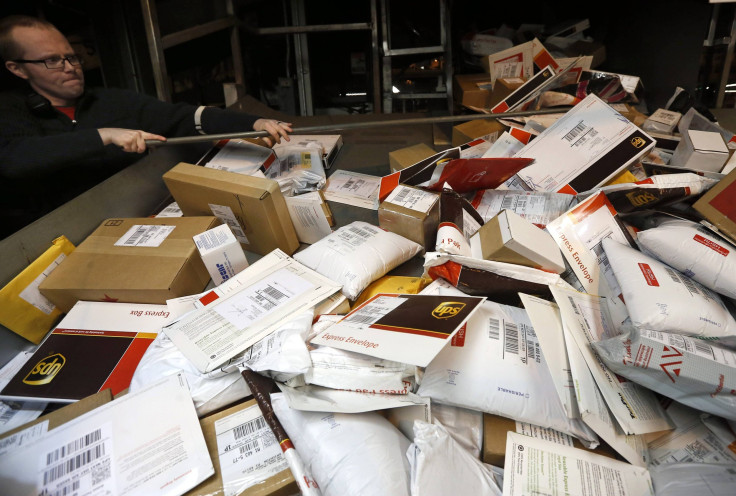Retail Shipping Wars 2014: Apple Meets Delivery Expectations, While Toys R Us And Staples Miss

After a series of late deliveries during the holidays in 2013, the shipping wars grew fierce this year as retailers apparently did a better job this time around fulfilling their order deadlines to procrastinating holiday shoppers. Tech giant Apple Inc., computer manufacturer Dell Inc., upscale fashion retailer Nordstrom Inc. and online shoe company Zappos.com Inc. all provided an aggressive guarantee that orders placed by Dec. 23 would be delivered by Christmas, and all four companies managed to meet that promise in all regions of the U.S., StellaService said in its annual study Friday.
But one striking difference this year was how late consumers waited to shop. During the weekend leading up to Christmas, nearly 11 percent of consumers still hadn’t started shopping, up significantly from 6 percent the prior year, according to a report by the International Council of Shopping Centers released Tuesday. “That’s a sizable increase in terms of the amount of procrastinators, and on top of that, even people who had started shopping earlier still hadn’t finished, a 10 percent increase for a year ago,” Jesse Tron, spokesman for ICSC, said.
During the week leading up to Christmas, Dec. 15-21, online holiday spending surged 18 percent to $5.8 billion from a year ago, according to researcher ComScore Inc.
StellaService placed four orders for 40 of the largest retailers, one to each region, including the East, Midwest, South and West. Nine of the 40 retailers missed delivery to at least one region, including consumer electronics company Best Buy, Costco Wholesale Corp., Crate & Barrel, J.C. Penney Co., Kohl’s Corp., Macy’s Inc. and Wayfair Inc., while Staples Inc. and Toys R Us Inc. missed deliveries in multiple regions. StellaService conducted the same study in 2013, and out of the 25 companies tested year to year, department stores Macy’s and Kohl’s, along with office supply chain store Staples, missed deliveries both years.
“You saw many of these packages leave the warehouse the same day the order was placed, which is the best effort the retailer can make,” Kevon Hills, StellaService vice president of research, said in the report. “Everyone seemed to learn from last year’s woes and make the proper improvements.”
Last year was one of the worst for shipping due to severe weather-related issues, along with overwhelming package volumes. “A lot of the shipping companies factored that in this year to give themselves a little bit more time, and more were not offering those last-minute options, just to really protect themselves,” Tron said.
Holiday sales are expected to rise 4.1 percent to $616.9 billion in 2014 compared with an increase of 3.1 percent to $592.7 billion a year ago, the National Retail Federation said. Meanwhile, online shopping is expected to rise 16 percent to $61 billion for the November to December period, according to ComScore. Mobile sales are expected to rise to $7.9 billion, a 25 percent jump from 2013.
“When you’re ordering that late, you are relying on a lot of different moving parts in the chain to come together, and there’s a lot of unforeseen things that can happen,” Tron said. “If you’re a procrastinator and like to wait to the last minute to shop, the best way to ensure you have something is to go to the store to get it, and a lot of people found out the hard way last year.”
Meanwhile, as the holiday shopping season winds down, courier companies such as United Parcel Service will be keeping busy through the new year. The company expects consumers will ship more than 800,000 packages back to retailers and merchants, and by the end of the first full week in January, UPS anticipates transporting 4 million return packages in the U.S.
Data earlier this week revealed consumer spending jumped last month in the midst of the holiday shopping frenzy with Black Friday and Thanksgiving Day weekend sales. Data Tuesday showed consumer spending, which accounts for nearly two-thirds of the U.S. economy, jumped to its largest gain in three months in November as falling gasoline prices left more discretionary income in consumers’ pockets during the holiday shopping season. Consumer spending rose 0.6 percent last month, while October was upwardly revised to a 0.3 percent increase, the Commerce Department said Tuesday.
Consumer optimism has continued to pick up as global oil prices continue to hover around five-year lows, causing gasoline prices to fall at the pump. The average price of gasoline across the U.S. is currently $2.322 per gallon, down 93 cents from a year ago, according to Gasbuddy.com.
“We are now running at a 15-percent growth rate in desktop e-commerce for the season, which should be taken as a very positive sign for the economic health of both the American consumer and the e-commerce channel as a whole,” ComScore Chairman Emeritus Gian Fulgoni said in a report Tuesday. “While the heaviest spending days of the season are now behind us, there is still about another $5 billion that will be spent over the balance of the year that will get us to new all-time highs for e-commerce.”
© Copyright IBTimes 2024. All rights reserved.












